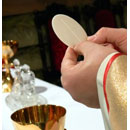Pierre Teilhard de Chardin described the Eucharist as “comparable to a blazing fire whose flames spread out like rays all round it.” Surely Chardin, passionately preoccupied with the cosmic explosion of the Eucharistic host, would have beamed to find the earnest crowd captivated by the same phenomenon that gathered in the lower level of the Art Institute of Chicago in February 2014 for the Association of Scholars of Christianity in the History of Art’s (ASCHA) sixth symposium. ASCHA’s mission is to create opportunities for scholarly discussions that are not happening in other forums, and this year’s theme was “Envisioning the Eucharist: Transcending the Literal in Medieval and Byzantine Art.” Keynote speaker Aden Kumler of the University of Chicago headlined a sparkling collection of six presenters from both sides of the Atlantic. The symposium featured papers investigating art that did not merely represent Eucharistic theology and tradition but were its driving force.
Kumler opened with the narrative of the famous Gregory Mass to raise a perennial question: how is Christ present in the Eucharist? Indeed, this question proved to be the pulse of the conference, its most refreshing and nuanced answers coming from the images themselves. The problem, as Kumler put it, is that “fleshly senses can’t sense the flesh”; that is, there must be some other way to know Christ truly resides in the host, as “the carnal incarnate Christ is imperceptible sensibly.” Kumler explained how the encounter with Eucharistic host comes as an answer to that difficulty, hovering in the liminal space between literality and transcendence, between human and divine. For Kumler, this in-betweenness is mediated by medieval works of art and artifice—the nature of the host as made by human hands and yet attaining transcendent “unmadeness.” Her paper burst the boundaries of traditional art history, verging into culinary arts as she explored how even the firewood used to bake the Eucharistic bread had to be carefully selected to fuel the holy fire. Kumler set the tone for the following presenters, mapping the ways the host is simultaneously far from mere bread and deeply, specifically bread.
Florian Wöller of Switzerland’s Universität Basel and doctoral student Nancy Thebaut presented papers that dovetailed neatly with Kumler’s, offering lenses through which to view the ambiguity Kumler described. Thebaut highlighted the different modes of beholding enabled by the use of paint in the 13th-century Echternach Evangeliaries, by which we see that “a single material can undergo a variety of semiotic and even ontological permutations, enacted by the artist” or, in the case of the Eucharist, by the priest. In the same vein, Wöller described the Eucharistic ambiguity as best expressed visually, as “images mainly show without saying what they show,” leaving room for the Hoc of Hoc est Corpus Meum to indicate unity in perplexity in a way verbal explanation simply cannot.
The afternoon session included presentations from Roland Betancourt, Dame Frances Yates Fellow Corinna T. Gallori, and Elizabeth C. Parker. Drawing from scholarship on virality in the digital age, Betancourt described the mechanics of Eucharistic presence using images of the Communion of the Apostles. Further probing the distinctions among image, word, and presence, Gallori laid out in dazzling array the varied use of “IHS,” or the holy name of Jesus, on the medieval host itself. The name of Jesus was the seal, the enactor, and the sign of Christ’s real presence in the bread. Finally, Parker used Antelami’s Parma Deposition, whose meaning functions on a number of interlocking levels, to lay out an analogous web for the Doctrine of Real Presence. She likened interaction with the image to interaction with the host itself. The day began with Kumler describing a proto-industrial practice of wafer production, its fabricators attempting to remove any human trace from the sacred bread; and it ended with Parker describing how one sculptor of a Eucharist Christ asserted his hand, associating himself with Nicodemus who not only took Jesus down from the cross, but also—tradition relates—sculpted Christ’s body as well.
Ranging from wide-eyed students to amateur art and theology enthusiasts and academic professionals, the symposium’s attendees represented an eclectic array of perspectives—and nowhere was that more evident than in the symposium’s concluding discussion. As the lights came on in Price Auditorium, organizers Matthew Milliner and James Romaine as well as the attendees lobbed questions at the presenters. They juggled the questions the audience posed, and one thing became clear: the images presented possessed a depth of visual theology that could be stirred and plumbed for much longer than the afternoon we had. In other words, the symposium had accomplished its goal. Visuals, it became apparent, have the power to reinforce mystery and, more important, to uphold the inexhaustibility of the problem of the Eucharist. Not only that, they present that “problem” as captivating and enfolding, inviting the faithful to encounter its infinite depths personally. Just as Teilhard de Chardin saw the host itself as spreading out into the world around it, sparing nothing from the glow of its expansive light, perhaps the images of the Eucharist examined at last week’s conference, too, explode outward and draw inward in a way that mirrors the host they represent. These schemas of representation and reality, of figural symbolism and real presence, undergird both the Eucharist as experienced in the liturgy, and its representation as encountered visually. Images have the power to show but also—more, perhaps, than we often suppose—to do.
Maddie Johnston is a senior at Wheaton College, where she is majoring in art history.
Copyright © 2014 Books & Culture. Click for reprint information.









